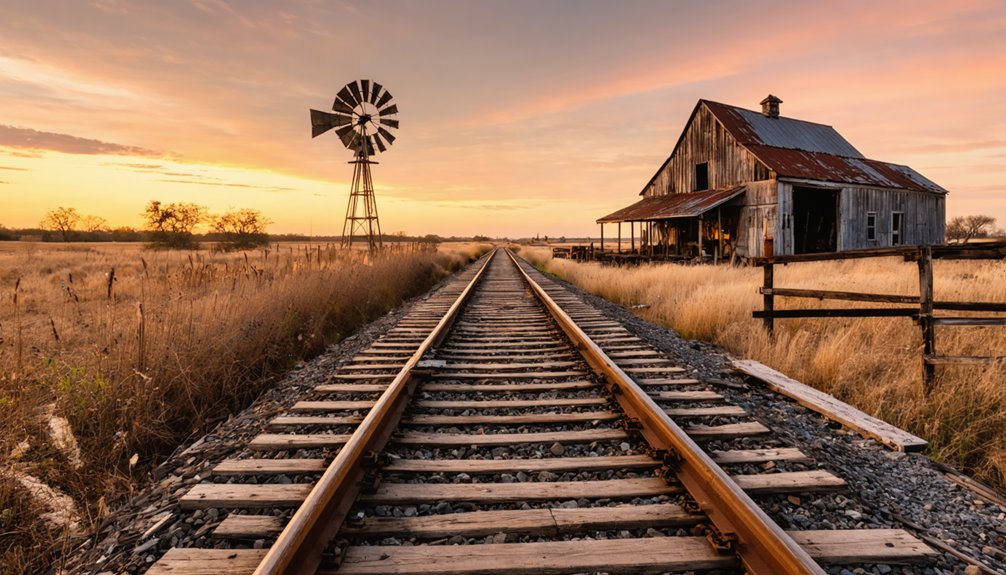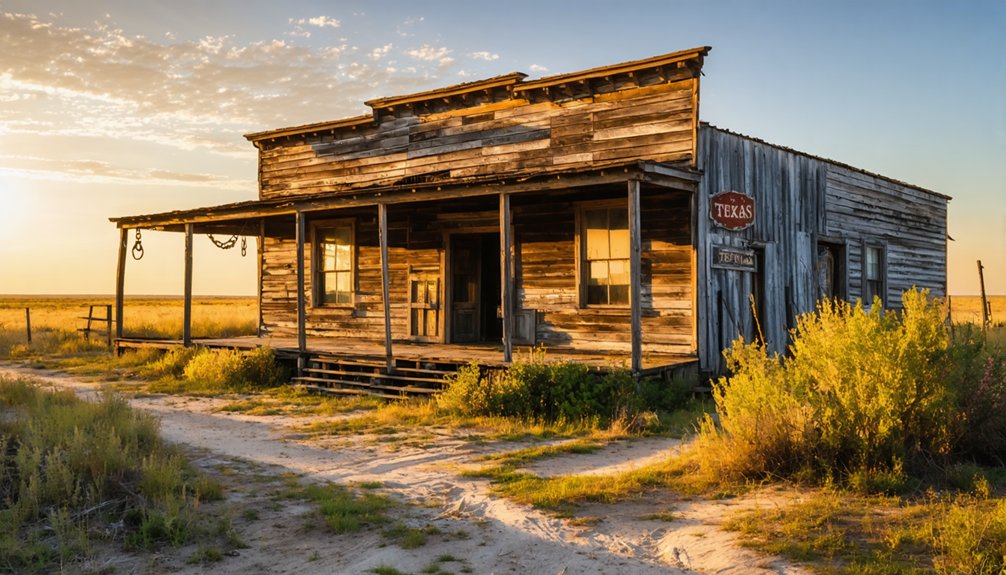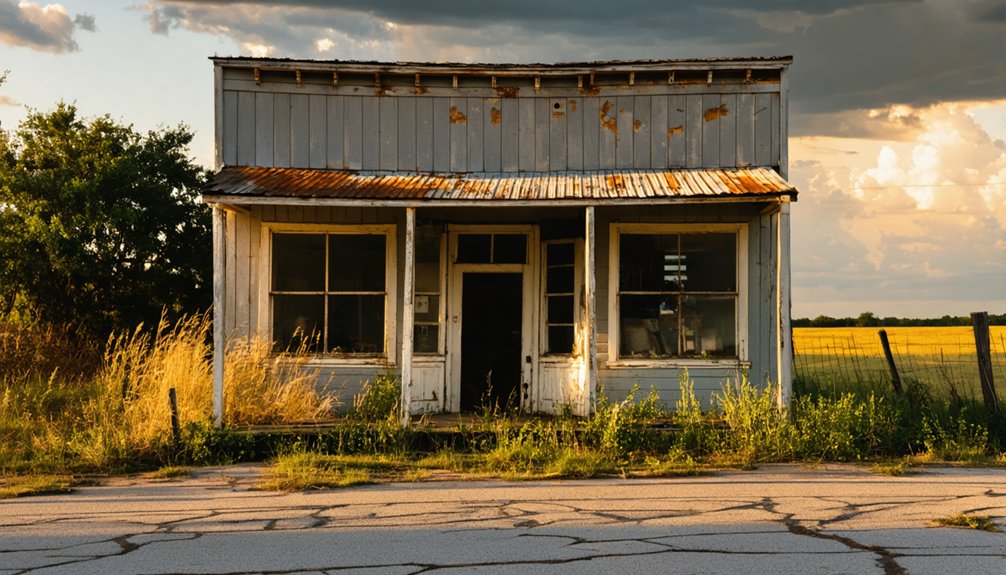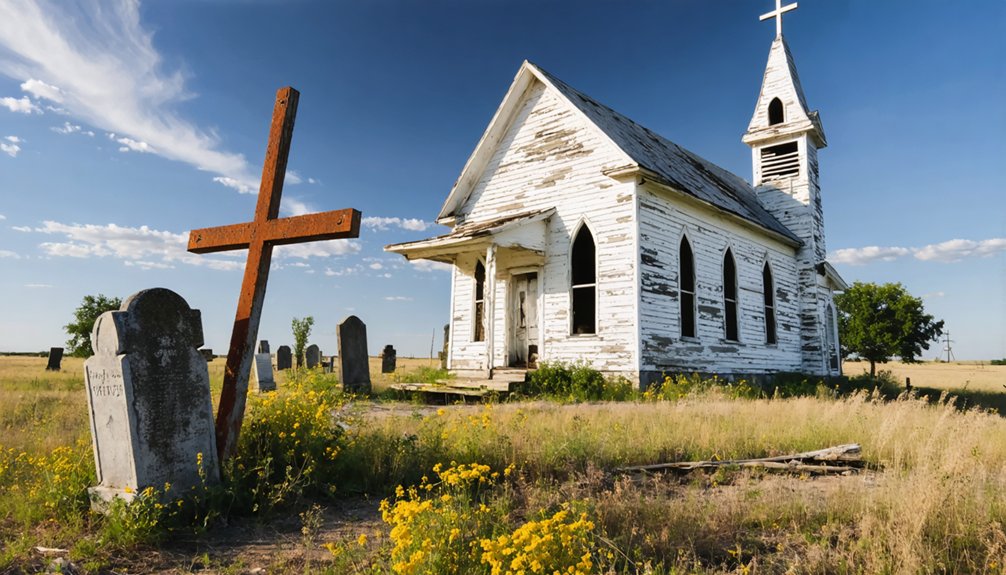You’ll find Ireland, Texas as a ghost town 16 miles northwest of Gatesville, though it once thrived as Hamco before 1911. When the St. Louis Southwestern Railway arrived, residents renamed it after Governor John Ireland, and the town flourished with 400 people by 1921. The community boasted a schoolhouse, bank, and prosperous cotton trade, but post-WWI declining cotton prices and shifting transportation patterns led to its abandonment. The weathered ruins and old cemetery still hold stories of this lost railway town.
Key Takeaways
- Ireland, Texas was originally named Hamco and became a ghost town after its brief prosperity during the WWI cotton boom era.
- The town reached its peak population of 400 in 1921, featuring a bank, schoolhouse, and churches before declining sharply.
- Named after Governor John Ireland in 1911, the town grew rapidly with the arrival of the St. Louis Southwestern Railway.
- By 1945, the population dropped to 40 people as younger residents left and rail transport gave way to automobiles.
- Today, the site contains weathered ruins, an old cemetery, and abandoned structures that attract photographers and history enthusiasts.
The Origins of a Texas Ghost Town
While many Texas ghost towns faded into obscurity without leaving much of a trace, Ireland’s origins can be traced to its earlier incarnation as the rural community of Hamco, situated 16 miles northwest of Gatesville at the Coryell-Hamilton county line.
You’ll find that this community’s identity transformed dramatically in 1911 when the St. Louis Southwestern Railway laid its tracks through the area. The Mid-Texas Improvement Company seized this opportunity, developing the newly accessible town site with remarkable economic resilience. The town soon established a two-story brick schoolhouse that served the growing community.
Local residents then successfully petitioned for a post office, naming their growing settlement “Ireland” in honor of former Texas Governor John Ireland. This strategic location at the county line, combined with essential rail access, positioned Ireland for its brief but significant role in Texas history. By 1921, the town had reached its peak with 400 residents and thrived on cotton farming.
From Hamco to Ireland: A Name’s Evolution
You’ll find the rural settlement of Hamco derived its original name from its unique position straddling Hamilton and Coryell counties, reflecting its identity before the arrival of the Cotton Belt Railway in 1911.
When postal officials requested a name change to prevent confusion, residents chose to honor former Texas Governor John Ireland, a prominent political figure whose legacy they sought to commemorate. Like the town of Grenada that became La Plata due to postal officials’ request, Ireland’s name change marked a significant transition in its identity.
The shift from Hamco to Ireland coincided with the town’s railway-driven expansion, as the Mid-Texas Improvement Company developed the area into a more formal settlement with a proper train depot and growing business district. Similar to Otis Chalk, the town experienced significant growth following the discovery of valuable natural resources in the region.
Original Name’s Rural Roots
Before becoming the town of Ireland, this rural settlement began as Hamco – a name derived from combining the first letters of Hamilton and Coryell counties to reflect its strategic location on their shared border.
The Hamco heritage was deeply rooted in agricultural beginnings, with scattered farms and ranches dotting the landscape before any formal development took place. Like many small Texas towns that would later face economic shifts, Hamco’s residents couldn’t predict they would share the fate of places like ghost town Thurber.
You’d have found a sparsely populated community where farming was the primary focus, and infrastructure remained minimal.
The area served as an informal gathering point for local agricultural producers, operating more as a rural crossroads than an established town.
While lacking official status, Hamco’s position made it a natural hub for the surrounding agricultural community, setting the stage for its future transformation.
Governor Ireland’s Local Impact
The renaming of Hamco to Ireland marked a significant shift in the town’s identity during the 1880s, reflecting the widespread influence of Texas Governor John Ireland.
You’ll find the governor’s influence extended beyond mere symbolism – his tenure coincided with critical railroad development that transformed the region’s accessibility and commerce.
Much like the Baltimore and Susquehanna Railroad had transformed communities in Maryland, the name change represented your community’s growing connection to state-level politics and broader Texan identity, moving away from purely local references.
This transformation mirrored similar changes across Texas, where towns sought prestige by adopting names of prominent political figures.
While Ireland eventually became a ghost town, the strategic choice to honor Governor Ireland helped establish a lasting local identity that transcended the settlement’s physical decline.
The town’s transformation paralleled the experiences of Irish tenant farmers who were forced to migrate and establish new communities in different locations.
Railroad Sparks Name Change
When the Stephenville North and South Texas Railroad arrived, it sparked a pivotal transformation in Hamco’s identity, leading to its renaming as Ireland.
You’ll recognize this identity transformation as part of a broader pattern across Texas towns, where railroad symbolism often drove strategic name changes. The community’s decision to honor Governor John Ireland wasn’t just about local pride – it reflected the town’s aspirations for greater recognition and economic growth.
The railroad’s presence offered more than just improved transportation; it provided an opportunity to rebrand and redefine the town’s future. Like the Alabama Great Southern Railroad which generated $1,092,692 in revenue in a single month, rail connections promised significant economic potential. This development mirrored the success of the Houston and Texas Central, which had already established vital rail connections across the state.
Through official administrative channels, the town formalized its break from its Hamco roots, embracing a name that connected it to state-level political prominence while positioning itself for railroad-driven prosperity.
Governor John Ireland’s Legacy
During his tenure as Texas’s 18th governor from 1883 to 1887, John Ireland left an indelible mark on the state’s development through his resolute leadership and institutional reforms.
Ireland’s governance tackled pressing challenges head-on, from quelling the Fence-Cutting War to managing labor strikes by the Knights of Labor.
Governor Ireland confronted Texas’s turbulent challenges directly, handling both violent range disputes and widespread labor unrest with firm resolve.
Having served as a lieutenant colonel in the Confederate army, Ireland brought military discipline to his approach to maintaining law and order in Texas.
You’ll find his most lasting impact in his education initiatives, where he established the University of Texas and created independent school districts with elected officials. He also appointed the first State Superintendent of Public Instruction to oversee Texas’s growing education system.
A champion of Texas pride, he insisted on using native pink granite for the State Capitol’s cornerstone instead of imported limestone.
Despite later financial setbacks in the Panic of 1893, his reforms modernized Texas during a critical post-Reconstruction period.
Railroad’s Impact on Local Development

While Governor Ireland shaped Texas through legislative reforms, his namesake town emerged through the transformative power of rail development.
You’ll find the St. Louis Southwestern Railway‘s 1911 expansion through Hamco marked the beginning of Ireland’s economic transformation. When the Cotton Belt Railway established its handsome depot, you’d have witnessed the town’s rapid growth as it connected local cotton farmers to lucrative European markets during World War I.
The railroad expansion catalyzed remarkable development – you’d have seen a bustling community of 400 residents by 1921, complete with a two-story brick schoolhouse, a $20,000-capital bank, three churches, and various merchants.
The rail line’s presence didn’t just enable agricultural commerce; it birthed a vibrant social infrastructure that defined Ireland’s golden age.
Agricultural Life and Early Settlement
As settlers established themselves in the rural community of Hamco, the promise of fertile cotton-growing land drew an increasing stream of farmers to the area.
You’d have found local agricultural practices enriched by Mexican neighbors who shared essential knowledge about crops, medicinal plants, and corn cultivation, fostering remarkable community resilience.
During World War I, you could’ve witnessed the town’s prosperity as European demand drove cotton prices skyward.
The population swelled to 400 by 1921, with three general stores, a drug store, and a restaurant serving the growing community.
A handsome train depot facilitated crop exports, while a two-story brick schoolhouse and three churches anchored community life.
The local bank, capitalized at $20,000, supported the agricultural economy until market prices collapsed in 1921, challenging the town’s continued growth.
The Path to Abandonment

The 1911 arrival of the St. Louis Southwestern Railway initially transformed Ireland into a bustling agricultural hub, but you’ll find its prosperity was short-lived.
While the railway brought immediate economic resilience through cotton exports to Europe during World War I, the town’s dependence on a single crop proved fatal when post-war prices plummeted.
The transportation evolution from rail to automobiles dealt another blow to Ireland’s survival. As highways bypassed the town and rail service declined, you’d see businesses and residents gravitating toward better-connected communities.
The town’s population, which peaked at 400 in 1921, steadily dwindled as younger generations sought opportunities elsewhere. Without economic diversification beyond agriculture and facing reduced access to markets, Ireland’s path to abandonment became inevitable.
Present-Day Remnants and Ruins
Standing amid the harsh desert landscape, Ireland’s remnants tell a compelling story of industrial decline through their weathered ruins and repurposed structures.
You’ll find classic ghost town architecture scattered throughout the mining district, with adobe, stone, and wooden buildings in various states of decay. The desert sun has bleached and eroded many roofless structures, while others have found new life as tourist accommodations and restaurants.
Ghost towns whisper stories through crumbling adobe walls and weathered wood, some finding rebirth as desert retreats for modern travelers.
The old cemetery remains one of the most intact features, drawing photographers who capture its historic graves against the backdrop of Big Bend National Park.
Tourism impact has preserved some buildings through adaptive reuse, though most structures continue their slow return to the earth. You can still trace the old roadbeds that once connected the bustling mining community, now serving as paths between the atmospheric ruins.
Historical Lessons From a Lost Community

When you trace Ireland’s trajectory from boom to bust, you’ll find the Cotton Belt Railway‘s arrival in 1911 sparked the town’s growth while its departure by 1942 sealed its fate.
You can see how the railway’s presence transformed Ireland from a small farming settlement into a thriving cotton shipping hub of 400 residents, complete with a bank, stores, and civic institutions.
Yet you’ll understand the town’s vulnerability as rural families, cut off from essential transportation networks, migrated away after the tracks were removed, leaving only 40 residents by 1945.
Transport Shapes Community Survival
Through Ireland’s rise and fall as a Texas community, you’ll find compelling evidence of how transportation infrastructure determined the fate of early 20th-century rural towns.
When the Cotton Belt Railway arrived in 1911, it transformed Hamco into Ireland, a bustling center of commerce with 400 residents, multiple businesses, and strong economic resilience. The rail line connected local cotton farmers to lucrative European markets, especially during World War I’s demand surge.
You’ll see how Ireland’s prosperity hinged entirely on rail access. Once that lifeline was severed, the town’s economic foundation crumbled.
This stark example shows why diversified transportation options matter – communities that rely on a single transport mode risk everything when that infrastructure disappears. Ireland’s story warns modern planners about the critical relationship between transport accessibility and community survival.
Rural Migration’s Hidden Costs
Beyond the railway’s influence, Ireland’s story reveals the devastating human toll of rural migration. You’ll see how the town’s dependence on cotton left it without economic resilience when prices crashed after WWI, triggering an exodus that transformed a thriving community of 400 into a mere shadow of 20 residents by the 2010s.
The consequences cut deeper than statistics suggest. As neighbors departed, you’d have witnessed the unraveling of community cohesion – the post office closed in 1970, schools shuttered, and a church became just another private residence.
The remaining inhabitants faced increasing isolation, while the aging population and youth outmigration created a demographic vacuum. Ireland’s transformation from bustling town to quiet ghost town serves as a stark reminder of how rural migration can hollow out the very soul of a community.
Frequently Asked Questions
Are There Any Dangerous Structures or Hazards When Visiting Ireland Today?
You’ll encounter unstable abandoned buildings with rotting foundations, collapsing roofs, and hidden hazards. Take safety precautions like wearing protective gear and avoiding entry into deteriorating structures.
What Native American Tribes Originally Inhabited the Ireland Area?
You’ll find the Tonkawa were primary inhabitants, while Comanche and Apache tribes later moved through the area. The region’s tribal history reflects rich indigenous culture spanning centuries of occupation.
Did Any Famous Outlaws or Historical Figures Pass Through Ireland?
Ever wonder about outlaw encounters in this frontier locale? While historical visits from notorious figures likely occurred given the region’s lawless reputation, there’s no documented evidence of specific famous outlaws passing through.
What Were the Major Crops and Livestock Raised in Ireland?
You’d find cotton farming dominated Ireland’s agricultural scene, while cattle ranching served as the secondary economic driver. Farmers also raised corn and other grains alongside sheep and hogs for sustainability.
Are There Any Local Legends or Ghost Stories Associated With Ireland?
Unlike many Texas ghost towns where haunted tales run wild, you won’t find documented spectral sightings in Ireland’s history. The town’s quiet decline was driven by economic hardship, not supernatural events.
References
- https://www.baltimoremagazine.com/section/historypolitics/lost-irish-immigrant-quarry-town-texas-baltimore-county/
- http://texasghosttowns.blogspot.com/2013/03/ireland-coryell-countyhamilton-county.html
- https://thebullamarillo.com/irish-history-a-happy-accident-and-the-quiet-town-of-shamrock-texas/
- https://en.wikipedia.org/wiki/List_of_ghost_towns_in_Texas
- https://www.texasescapes.com/CentralTexasTownsNorth/Ireland-Texas.htm
- https://www.texasescapes.com/TOWNS/Texas_ghost_towns.htm
- https://thedaytripper.com/most-irish-places-in-texas/
- http://texasghosttowns.blogspot.com/2013/03/
- http://www.heritage.umd.edu/chrsweb/Texas_MD/Texas_Overview.htm
- https://www.tshaonline.org/handbook/entries/san-patricio-tx



